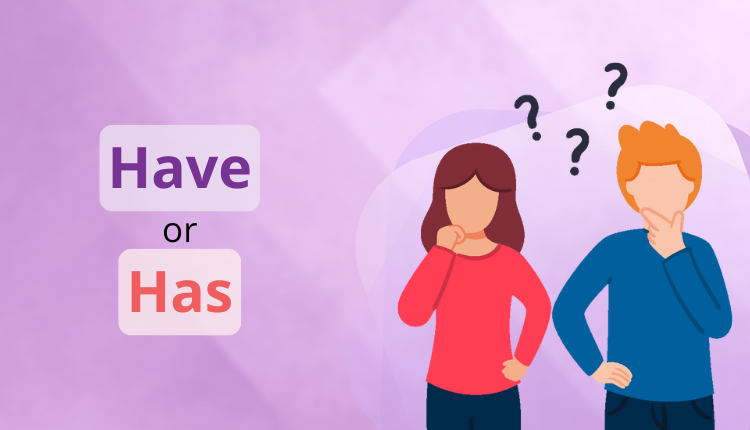Working with the English language is not always easy, particularly when dealing with simple verbs such as “have” and “has.” These two verbs may be straightforward, but their proper use can make a big difference in your writing.
Whether you are writing an email or a novel, knowing the differences between “have” and “has” is important to communicate effectively. Let’s get into this basic grammar subject and discover the differences that will make your writing even better!
Knowing the Fundamentals of “Have” and “Has”
“Have” and “has” are both the verb “to have” in different forms. The only difference between them is their subjects. “Have” goes with plural nouns and pronouns, while “has” goes with singular ones.
For instance, you’d say “I have a book” or “They have ideas.” Conversely, you’d say “he has a car” or “she has talent.” Knowing this rule is crucial for building grammatically correct sentences.
Correct Usage of “Have”
“Have” is mainly used with the first and second persons’ subjects like “I,” “you,” “we,” and “they.” For instance, you would say, “I have a car” or “We have been friends for years.” It expresses possession or experience.
Moreover, it occurs in perfect tenses. For example, “They have finished their homework” indicates an action done in the past which still holds significance today. Knowledge of these contexts may assist in maintaining appropriate usage of this serviceable verb.
Correct Usage of “Has”
“Has” is the third person singular form of “have.” It is employed with he, she, and it. For instance, you would use “She has a new car” or “He has completed his homework.
Use “has” when talking of something that belongs to one person or talking of actions done by him or her. Keep in mind, in case your subject is not the third person singular, you must use “have.” Understanding the difference can help your writing make sense.
Sentence Examples Using “Have” and “Has”
“Have” is mostly used with first-person and plural subjects. For instance, “I have a meeting tomorrow.” Another sentence can be, “They have finished their project ahead of time.”
Conversely, “has” is used with third-person singular subjects. You can say, “She has a nice voice.” Another one is, “He has completed his homework on time.” These examples show how context defines whether to use “have” or “has.”
Common Errors and Avoiding Them
Most individuals misunderstand “have” and “has,” resulting in common grammatical mistakes. One of the common errors is placing “has” after plural subjects, such as in the sentence “They has a car.” Keep in mind that only singular third-person subjects use “has.”
Another error occurs when using contractions. For example, some might say “I’ve” instead of correctly stating “I have.” Paying attention to subject-verb agreement is key. Proofread your sentences carefully to catch these missteps before they become habits that stick!
Using “Have” and “Has” with Other Verbs
When “have” and “has” are used with other verbs, context is everything. These helping verbs tend to combine with past participles to create perfect tenses, such as in “I have finished” or “She has completed.” This construction expresses actions that are pertinent to the present.
Don’t forget that “have” is used with plural subjects and the pronoun “I,” whereas “has” goes with singular third-person subjects. For example, you would say “They have gone” but “He has left.” Having these rules in mind will improve your grammar.
Improving your grammar can have a big impact on your writing. Trinka is a high-level grammar-checking software that aims to assist you in making your language use better. It provides real-time recommendations so that you use “have” and “has” every time in the right way.
With Trinka, you will get personalized feedback based on your writing pattern. This not only corrects grammatical mistakes but also helps you grasp the subtleties of English so that you can easily learn concepts like have vs has.
Conclusion
Learning how to use “have” and “has” is crucial to communicate effectively. Grasping the subtleties enables you to express your ideas clearly.
Welcome these differences as a means to improve your writing. With practice, you’ll discover that employing “have” and “has” becomes second nature in a matter of moments.
FAQs
"Have" and "has" are two versions of the verb "to have," yet their application depends on the subject. "Have" applies for I, you, we, and they. For instance, "I have a cat" or "They have a meeting today." On the contrary, "has" goes with he, she, it, and singular nouns. For instance, "She has a great idea." Being aware of this difference ensures proper grammar in your work.
The choice between "have" and "has" often depends on the subject of your sentence. Use "have" with I, you, we, and they. For example, “I have a dog,” or “They have completed their project.” Contrarily, use "has" with he, she, it, or singular nouns. You could say, "She has an incredible talent," or "The cat has located its toy." Remembering these easy guidelines will make your writing clear and seamless.
To put the distinction between "have" and "has" in even clearer terms, here are some examples: 1. I have a meeting at 10 AM. 2. She has a lovely garden. 3. They have finished their homework. 4. He has a fascinating outlook on the subject. These sentences illustrate how "have" is employed with plural nouns and the pronouns I, you, we, and they, while "has" goes with third-person singular nouns such as he, she, or it. Grasping these subtleties can greatly improve your grammar!

